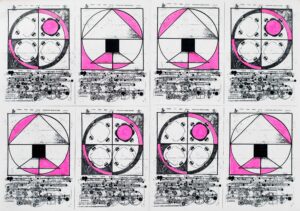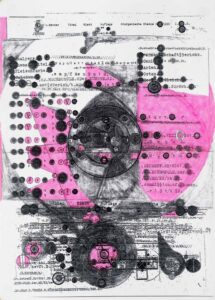Dans son accumulation obsessive Adelhyd van Bender produit alors 2000 classeurs comprenant chacun entre 200 et 250 pages de collages composés de formes géométriques, de champs de couleurs, de graphismes et de formules mathématiques et physiques qu’il photocopie puis sur lesquelles il ré intervient. Adelhyd van Bender pense être doté d’un utérus, qui contient un « secret atomique ».
BENDER van adelhyd (1950 . bruchsal . allemagne/2014 . berlin . allemagne)
À 15 ans, après la séparation de ses parents, Adelhyd van Bender est placé dans un foyer pour mineurs où il apprend le métier d’électricien. En 1968, il déménage à Berlin et exerce sa profession. En 1974, il suit les cours du soir pour obtenir son baccalauréat et en octobre de la même année, il est admis à l’HdK Berlin (Université des Arts de Berlin), où il étudie pendant deux ans. En 1976, radié de l’université et après avoir été expulsé de son appartement, il se rend en Angleterre, à la recherche de ses racines aristocratiques, un épisode qui le conduit à désormais se nommer Adelhyd van Bender. L’année suivante, de retour à Berlin il se consacre tout entier à son activité artistique, mais en 1987, l’incendie de son appartement détruit une grande partie de son travail. Cette période dramatique transforme radicalement son regard sur le monde et son style artistique, il se pense dès lors investi d’une mission – une corvée dit-il – dictée par une autorité supérieure. Dans son accumulation obsessive Adelhyd van Bender produit alors 2000 classeurs comprenant chacun entre 200 et 250 pages de collages composés de formes géométriques, de champs de couleurs, de graphismes et de formules mathématiques et physiques qu’il photocopie puis sur lesquelles il ré intervient. Adelhyd van Bender pense être doté d’un utérus, qui contient un « secret atomique ». Le cube, associé au symbole de la Kaaba, le cube noir de la Mecque sont des formes récurantes de son travail ainsi que les constellations planétaires, les roquettes et les torpilles. Avec ce travail abondant de 450.000 pages produit en 25 ans Adelhyd van Bender semble avoir réussi à contenir le chaos.
Adelhyd van Bender developed hundreds of three-ring binders brimming with A3 and A4 papers neatly sorted and sequenced in individual plastic sleeves. On its pages – on a ground of black text typewritten and Xeroxed onto the white pages – the artist had collaged, drawn, and hand-coloured geometric diagrams. Van Bender’s drawings show a proclivity for the particles of the atom: protons, electrons, neutrons. They evoke the Bohr model of the atom, or the geocentric or heliocentric order of the universe and its revolving planets, and they emulate mystical diagrams, like the Sephiroth from the Kabbalah. A recurring source of van Bender’s concentric diagrams are nuclear radiation maps and atomic diagrams. Rocket or missile shapes frequently consume a page of collaged diagrams and form a massive, upwardly pointed, projectile-like form. Bender’s practice was focused on gradually solving a deeper secret, while generating a meticulous and rich visual language with its own internal logic – a process the artist described as the ‘divine drudgery.’
Adelhyd van Bender (b. 1950, Bruchsal; d. 2014, Berlin) donated most of his works to Prinzhorn Collection, Heidelberg in 1999. His works were exhibited at Malmö Konsthall; Künstlerhaus Stuttgart (both 2019) and Delmes & Zander, Cologne (2018), who represent his estate.
https://www.moussemagazine.it/magazine/adelhyd-van-bender-tina-kukielski-2015/
The universe of Adelhyd van Bender is based on a complex and cryptical structure, a sacred atomic system whose decoding kept this unusual high priest of art engaged until his death. His apartment overflowing with binders packed with papers, walls densely covered with compositions and symbols, has been the temple of an impenetrable cult for many years, of which the artist was the overseer. Tina Kukielski, with scientific rigor, has explored this dense cosmos to offer us the image of a particular man, against the backdrop of the Cold War, whose art formulated the only response in the face of a world on the brink of self-destruction.
Time spent in van Bender’s universe shows a proclivity for the particles of the atom: protons, electrons, neutrons. The combination of small circles found in clusters, in a grid, or frequently interrupting concentric circles, suggests several things at once. In their gridded form they resemble the clustering of atoms in an electrical conductor, and, knowing that van Bender once studied and briefly practiced as an electrician, this is a likely point of comparison. In their circular arrangements, the patterns suggest chemical bonds or compounds in inorganic chemistry (a frequent subheading at the top of his ledgers). They evoke the Bohr model of the atom, or the geocentric or heliocentric order of the universe and its revolving planets, and they emulate various mystical diagrams, for instance the Sephiroth from the Kabbalah tradition or mandalas from Hinduism or Buddhism. Most convincing as a possible source of van Bender’s concentric diagrams are nuclear radiation maps and atomic diagrams. The artist’s research and interest in nuclear power is evidenced in printouts, source materials, and references found in his binders: maps of purported nuclear plants in Germany, plans for the city of Moscow, radiation warning symbols. Most overt are the rocket or missile shapes that frequently consume a page of collaged diagrams and form a massive, upwardly pointed, projectile-like form. In several composite drawings in enlarged text this is labeled “Atomgemeinschaft” (atomic energy).
https://www.moussemagazine.it/magazine/adelhyd-van-bender-tina-kukielski-2015/


